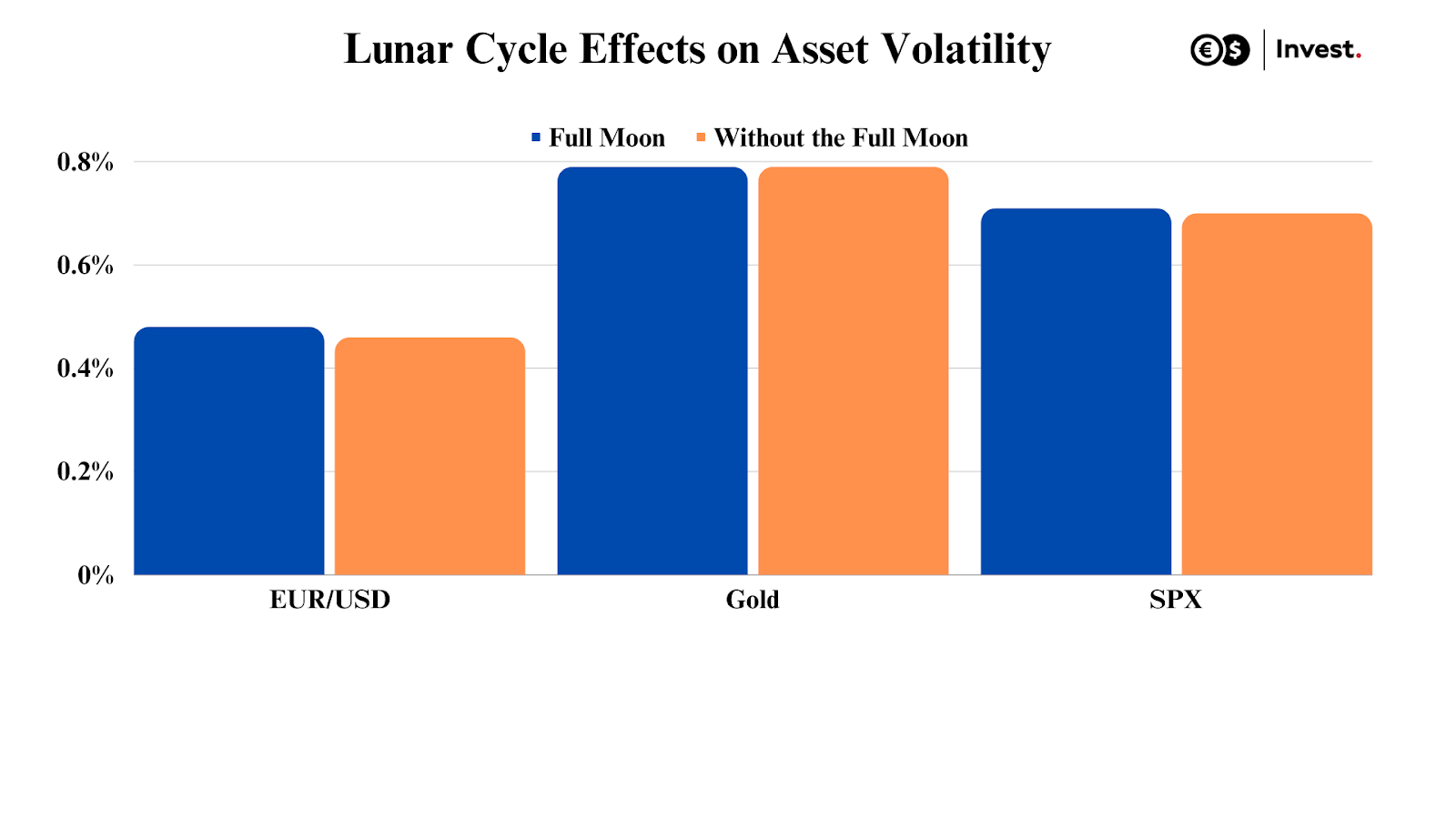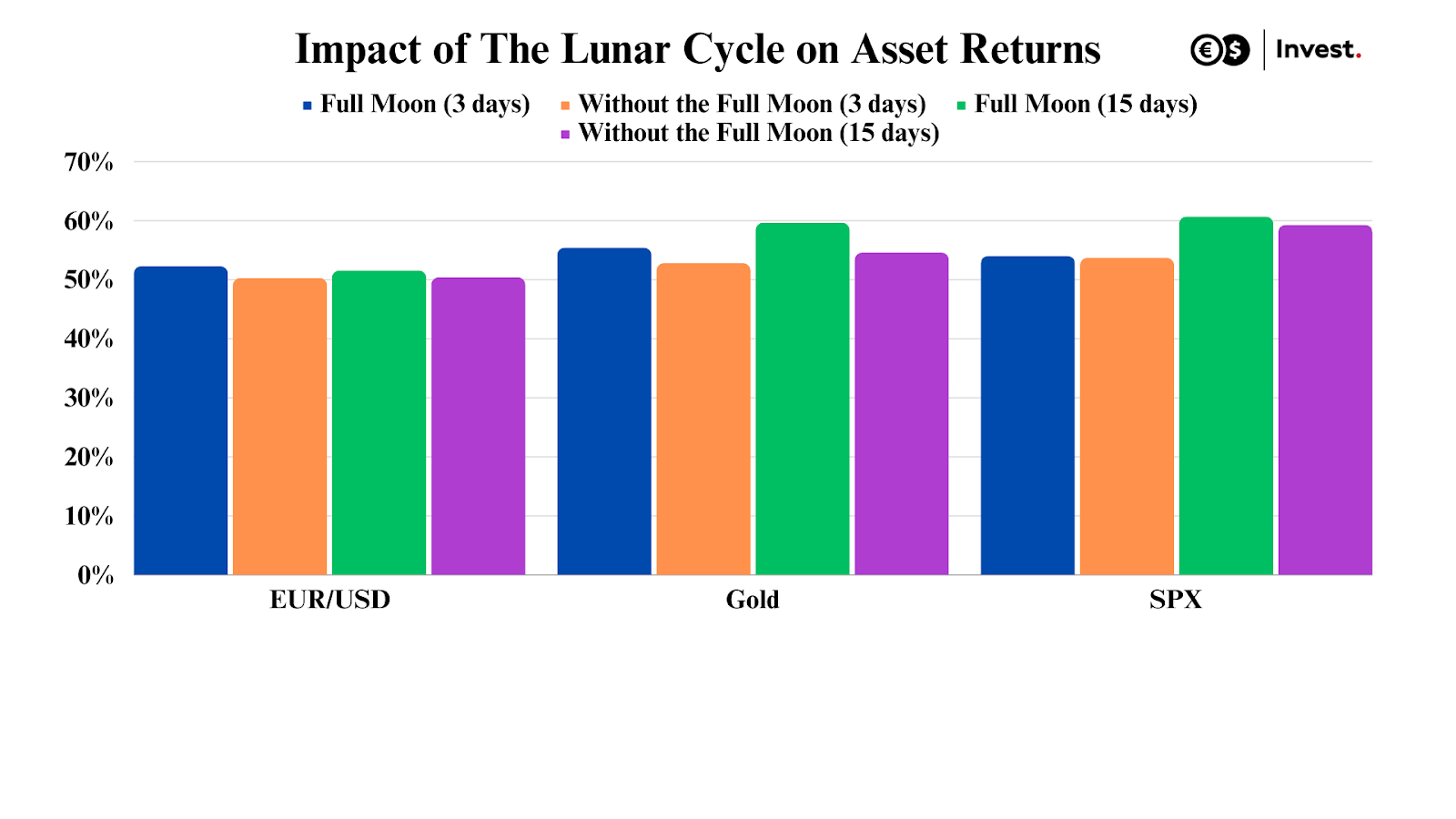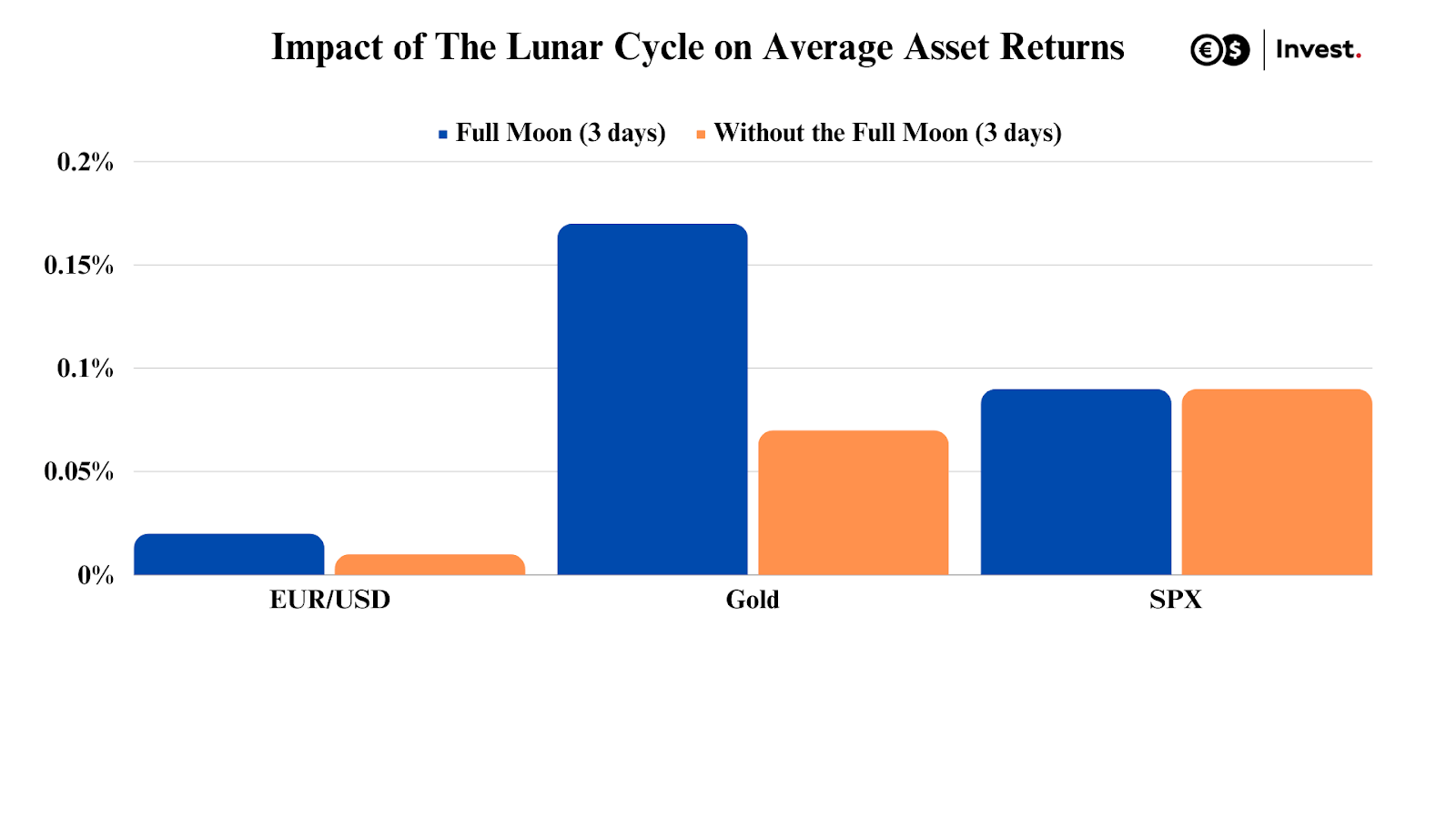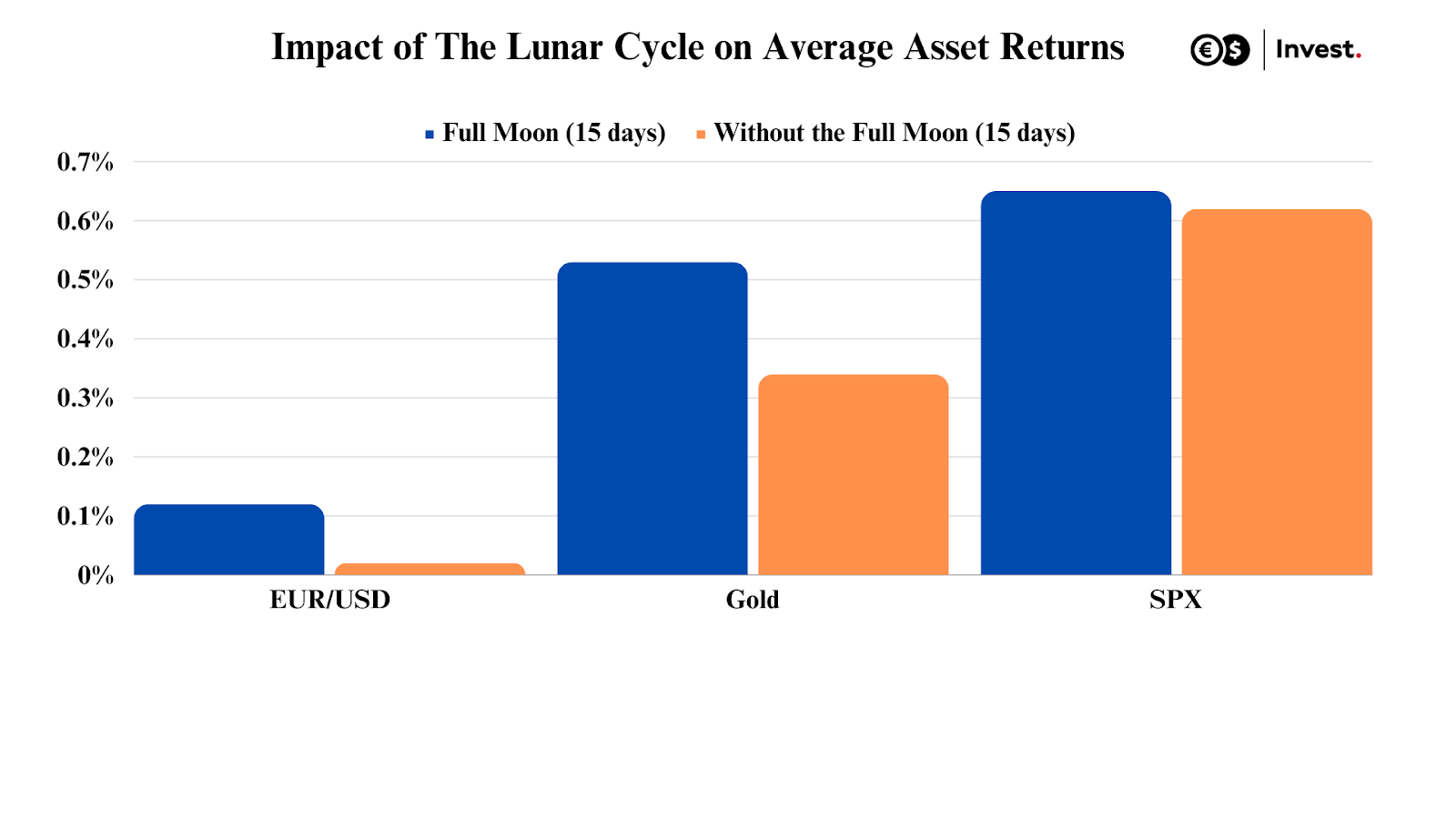With the ubiquitous advances in technology and data analytics, some investors are beginning to look to nature for answers to questions about financial markets. One such question that has intrigued investors and market observers alike for centuries is the Lunar cycle effects in stock returns, proposed by two University of Michigan professors. The theory is that, for thousands of years, people have believed that the cycles of the moon affect human behaviour, especially during full moons, increasing the risk of mental disorders, violence and other deviations. This phenomenon could not fail to affect financial markets and investors. Let us try to approach this issue analytically and examine the effects of the phenomenon on the major markets.
Spis treści:
- What is the impact of the lunar cycle on stock returns?
- Do we notice increased volatility on the SPX, gold and EUR/USD during the full moon?
- Does it make sense to invest during the full moon in the SPX, gold and EUR/USD?
- Conclusions
What is the impact of the lunar cycle on stock returns?
For centuries, people have believed that the cycles of the moon influence human behaviour, peaking at the full moon, which would supposedly increase the propensity for mental disorders and violence. These beliefs date back to ancient Greece and Rome, and sweep through the Middle Ages to the present day. The moon and its cycles have long been considered important in religious ceremonies and calendars.
Research into the influence of the lunar cycle on human behaviour is extensive, with some suggesting a correlation between the phases of the moon and abnormal behaviour. However, in-depth scientific analyses challenge these beliefs, arguing that the effects of the lunar cycle are insignificant or practically non-existent.
Research on the effects of the lunar cycle on investment and stock returns has become a focus of interest because there is a widespread belief that abnormal behaviour peaks or increased volatility during the full moon. However, in financial markets, investors' beliefs are often translated into the listing of financial instruments. Therefore, whether or not the full moon influences our emotions, let us examine this phenomenon in the financial markets.
Do we notice increased volatility on the SPX, gold and EUR/USD during the full moon?
To investigate whether we see increased volatility in financial markets during a full moon, we will measure it for three popular instruments: EUR/USD, the S&P 500 index and gold compared to sessions without a full moon since 2000.

Source: Conotoxia own analysis
As can be seen, the average daily variability is practically no different for full days than for non-full days. Hence, it is difficult to draw the conclusion of increased volatility during the full moon. However, did the full moon have an impact on asset returns?
Does it make sense to invest during the full moon in the SPX, gold and EUR/USD?
Full moons occur on average every 30 calendar days. Therefore, in order to examine the effect of the lunar cycle on the returns of the different asset classes, let us first examine what percentage of investments ended up with a profit after a period of 3 and 15 days.

Source: Conotoxia own analysis
Regardless of the period and asset class, the effectiveness seems similar whether we would invest during a full moon or any other period. Gold appears to show an advantage in favour of the lunar cycle theory in the 15 days following the full moon. However, the difference is small enough to be considered a statistical error.
The average returns for the two periods are as follows.

Source: Conotoxia own analysis
The rates of return for the 3 days after the occurrence of the full, although they turned out to be higher for gold and EUR/USD, can be called marginal differences. The average return ranged between 0.02 and 0.17%. In the case of the S&P 500 index, the average return showed no difference whether or not we bought the index during the full moon.

Source: Conotoxia own analysis
When extended, the differences show a slight advantage of the moon cycle effect for EUR/USD and gold. However, here too, average returns ranged between 0.02 and 0.65% for all asset classes. However, it is hard to call a strategy that at best delivers an average return of less than 0.2% over the usual period a breakthrough. Such a deviation also seems to be related to some kind of statistical error.
Conclusions
No matter from which perspective we examine - be it volatility, returns or efficiency - we do not find conclusive evidence of a lunar cycle effect in financial markets. Despite long-standing beliefs about the influence of the phases of the moon on human behaviour, the data do not unequivocally support the existence of this effect.
The average daily volatility in financial markets, including for the EUR/USD, the S&P 500 index and gold, is virtually no different on full days than on non-full days. The lack of significant differences indicates the stability of volatility during the full moon.
Analysis of returns for different periods after the full moon suggests that these differences are marginal and do not have a significant impact on investment decisions. Even if returns for gold and EUR/USD are slightly higher after a full moon, these differences are minimal and can be considered a statistical error. Therefore, rather this type of method should be treated more with a smile on its face than as a rigid investment strategy.
Grzegorz Dróżdż, CAI MPW, Market Analyst of Conotoxia Ltd. (Conotoxia investment service)
Materials, analysis and opinions contained, referenced or provided herein are intended solely for informational and educational purposes. Personal opinion of the author does not represent and should not be constructed as a statement or an investment advice made by Conotoxia Ltd. All indiscriminate reliance on illustrative or informational materials may lead to losses. Past performance is not a reliable indicator of future results.
CFDs are complex instruments and come with a high risk of losing money rapidly due to leverage. 71.98% of retail investor accounts lose money when trading CFDs with this provider. You should consider whether you understand how CFDs work and whether you can afford to take the high risk of losing your money.


